Mount the engine block onto the engine stand. Wash and dry the block including the cylinder bores, oil passages and crankshaft. Replace any freeze or oil galley plugs that were removed during disassembly.
NOTE: The oil holes in the bearing inserts must be aligned with the oil holes in the cylinder block.
- Position the upper main bearing inserts in the bores aligning the tang with the notch.
- Install the lower main bearing inserts on the bearing caps.
- Carefully lower the crankshaft into place. Be careful not to damage any bearing surfaces.
- Check the clearance of each main bearing by placing a piece of PlastigageŽ or its equivalent, on the bearing surface across the full width of the bearing cap, about 1/4 inch off center.
- Install the corresponding bearing cap and torque the bolts to specifications.
| Checking bearing clearance with gauging material
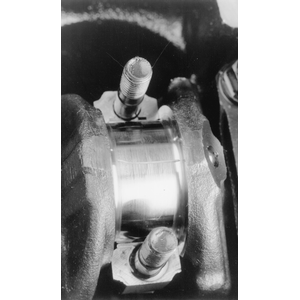
|
- Remove the cap; check the width of the PlastigageŽ at its widest point to get the maximum clearance and its narrowest point to get the minimum clearance. The difference between the readings is the oil clearance.
NOTE: Do not turn the crankshaft while the PlastigageŽ is in place.
| Measuring bearing clearance gauging material
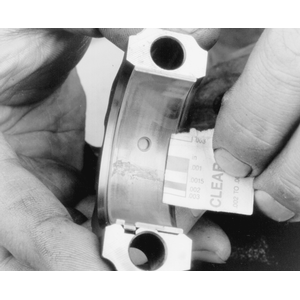
|
If clearance exceeds specified limits, try a 0.001 in. or 0.002 in. undersize bearing in combination with the standard bearing. Bearing clearance must be within specified limits. If a standard and 0.002 in. undersize bearing does not bring clearance within desired limits, refinish crankshaft journal, and install undersize bearings.
- Install the rear main seal.
NOTE: Be sure that main bearing caps are installed in the original locations.
- After the bearings have been fitted, apply a light coat of engine oil to the crankshaft journals and bearings.
- Install the rear main bearing cap.
- Install all bearing caps except the thrust bearing cap.
- Torque all bearing cap bolts to specification.
- Install the thrust bearing cap as follows:
- Install the bearing cap with bolts finger-tight.
- Pry the crankshaft forward against the thrust surface of the upper half of the bearing.
- Hold the crankshaft forward and pry the thrust bearing cap to the rear.
- Retain the forward pressure on the crankshaft and torque the cap bolts to specifications.
- Measure the crankshaft end-play as follows:
| Use a dial gauge to check crankshaft end-play
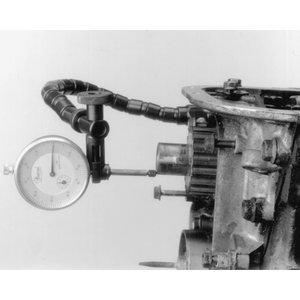
|
- Mount a dial gauge to the engine block and position the tip of the gauge to read from the crankshaft end.
- Pry the crankshaft toward the rear of the engine and zero the gauge.
| Measuring crankshaft end-play
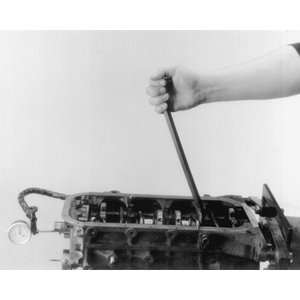
|
- Pry the crankshaft toward the front of the engine and read the gauge.
- Confirm that the reading is within the specified range.
- If not, install a new thrust bearing and repeat the procedure.
- If the measurement remains out of the specified range after installing a new thrust bearing, inspect the thrust surfaces of the crankshaft, and if possible, repair it.
- Rotate the crankshaft to position the first rod journal (cylinder number one) to the bottom of its stroke.
Before installing the piston/connecting rod assembly, oil the pistons, piston rings and the cylinder walls with light engine oil.
- Install connecting rod bolt protectors or rubber hose onto the connecting rod bolts/studs.
- Select the proper ring set for the size cylinder bore.
- Position the ring in the bore in which it is going to be used.
- Push the ring down into the bore area where normal ring wear is not encountered.
- Use the head of the piston to position the ring in the bore so that the ring is square with the cylinder wall. Use caution to avoid damage to the ring or cylinder bore.
- Measure the gap between the ends of the ring with a feeler gauge. Ring gap in a worn cylinder is normally greater than specification. If the ring gap is greater than the specified limits, use an oversize ring set.
| Checking ring groove clearance
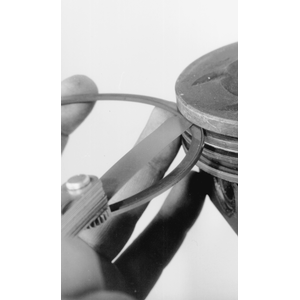
|
- Check the ring side clearance of the compression rings with a feeler gauge inserted between the ring and its lower land according to specification. The gauge should slide freely around the entire ring circumference without binding. Any wear that occurs will form a step at the inner portion of the lower land. If the lower lands have high steps, the piston should be replaced.
| Bearing cap notch
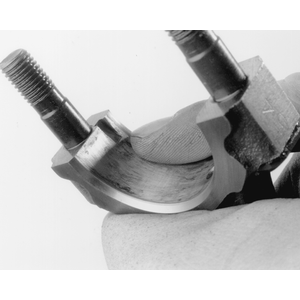
|
- Unless new pistons are installed, be sure to install the pistons in the cylinders from which they were removed. The numbers on the connecting rod and bearing cap must be on the same side when installed in the cylinder bore. If a connecting rod is ever transposed from one engine or cylinder to another, new bearings should be fitted and the connecting rod should be numbered to correspond with the new cylinder number. The notch on the piston head goes toward the front of the engine.
- Install all rod bearing inserts into the rods and caps.
| Ring top side marks
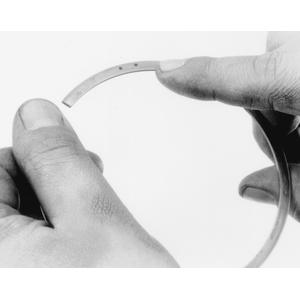
|
- Install the rings on the pistons. Install the oil control ring first, then the second compression ring and finally the top compression ring. Use a piston ring expander tool to aid in installation and to help reduce the chance of breakage.
| Piston and rod assembly installation
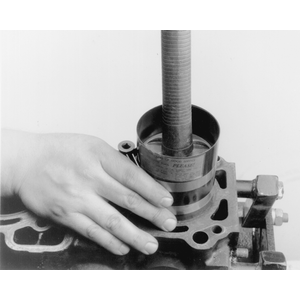
|
- Make sure the ring gaps are properly spaced around the circumference of the piston. Fit a piston ring compressor around the piston and slide the piston and connecting rod assembly down into the cylinder bore, pushing it in with the wooden hammer handle. Push the piston down until it is only slightly below the top of the cylinder bore. Guide the connecting rod onto the crankshaft bearing journal carefully, to avoid damaging the crankshaft.
- Check the bearing clearance of all the rod bearings, fitting them to the crankshaft bearing journals. Follow the procedure in the crankshaft installation above using PlastigageŽ.
- After the bearings have been fitted, apply a light coating of assembly oil to the journals and bearings.
- Turn the crankshaft until the appropriate bearing journal is at the bottom of its stroke, then push the piston assembly all the way down until the connecting rod bearing seats on the crankshaft journal. Be careful not to allow the bearing cap screws to strike the crankshaft bearing journals.
- After the piston and connecting rod assemblies have been installed, check the connecting rod side clearance on each crankshaft journal.
- Prime and install the oil pump and the oil pump intake tube.
- Install the assembled auxiliary/balance shaft(s).
- Install the camshaft.
- Install the timing gears/chain assembly.
- Install the lifters/followers into their bores.
- Install the cylinder head(s) using new gaskets and torque to the specified amount.
- Assemble the valve train (pushrods and rocker arms and/or shafts).
- Install the cylinder head(s) using new gaskets and torque to the specified amount.
- Install the timing sprockets/gears and the belt/chain assemblies.
Install the timing cover(s) and oil pan. Install any components that were removed from the engine after it was lifted from the engine compartment.

